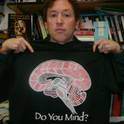tIntegrating research efforts using a cross-domain approach could redefine traditional constructs used inbehavioral and clinical neuroscience by demonstrating that behavior and mental processes arise not fromfunctional isolation but from integration. Our research group has been examining the interface betweencognitive and emotional processes by studying inhibitory gating. Inhibitory gating can be measured viachanges in behavior or neural signal processing. Sensorimotor gating of the startle response is a well-usedmeasure. To study how emotion and cognition interact during startle modulation in the animal model,we examined ultrasonic vocalization (USV) emissions during acoustic startle and prepulse inhibition. Wefound high rates of USV emission during the sensorimotor gating paradigm and revealed links betweenprepulse inhibition (PPI) and USV emission that could reflect emotional and cognitive influences. Measur-ing inhibitory gating as P50 event-related potential suppression has also revealed possible connectionsbetween emotional states and cognitive processes. We have examined the single unit responses dur-ing the traditional gating paradigm and found that acute and chronic stress can alter gating of neuralsignals in regions such as amygdala, striatum and medial prefrontal cortex. Our findings point to the need for more cross-domain research on how shifting states of emotion can impact basic mechanisms of information processing. Results could inform clinical work with the development of tools that depend upon cross-domain communication, and enable a better understanding and evaluation of psychological impairment.
- Inhibition,
- Brain Signals,
- Affective States,
- Motivation
Available at: http://works.bepress.com/howard_casey_cromwell/15/
